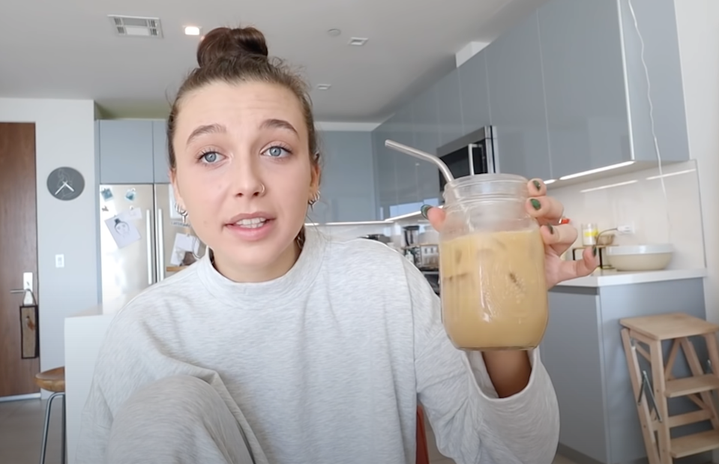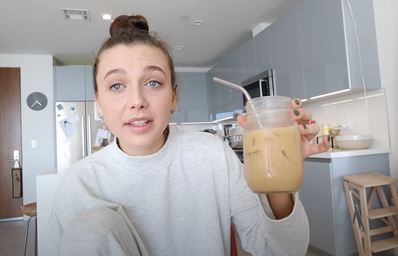We all know Emma Chamberlain is the queen of fashion, so when she had something to say about micro-trending, I was all ears. She pointed out the dangers of micro-trending and how it’s negatively impacting us in her podcast, Anything Goes With Emma Chamberlain. It’s important as consumers to pay attention to the things she discussed in order to be more self-aware on how we shop and participate in fashion.
The 20-year-old Youtube star used the House of Sunny Hockney Dress as a prime example. It was a single piece that we were all obsessed with; everyone just had to have it after blowing up on TikTok. After a few weeks, no one wore it or talked about it again — they were on to a new piece. Imagine every girl who bought this green dress: they just threw it to the back of their closet with the rest of their old trendy clothes to make room for the newest big thing. This really brought me to think about the effect TikTok has on fashion. TikTok inspires trends and just as quickly as the video goes viral, it’s forgotten soon after. Micro-trending in today’s society is a product of social media, mainly TikTok.
I noticed micro-trending when SHEIN became popular, and it didn’t take much to realize how much it affects fast fashion. We loved patchwork jeans for a month, and everyone ordered the same pair from SHEIN because of how cheap and accessible it was. Soon after, we moved on to bright patterned pants instead. I haven’t seen anyone wear patchwork since. What did all those people do with those patchwork pieces? From personal experience, I remember spending hundreds of dollars on brown clothing items from SHEIN because that’s all anyone was wearing. By the time the clothes got shipped to me, TikTok was telling me to order sage green. I felt out of place wearing my monochromatic brown outfits that I was just so excited to wear. “Is it weird if I wear this? Is brown too last month?” I would think to myself before leaving the house. As someone who is a college student that shamefully loves SHEIN as much as anyone else, we spend way too much time buying package after package to keep up with what’s in and throwing the most recent one to the back of closets to collect dust. It’s not only unsustainable but also financially draining. This past year, I scrolled past the basics section and went straight for the bold pieces that I thought would make me stand out, which proved to be the pieces I didn’t want to wear after a few weeks. Looking at this now, I have come to realize that you can stand out and be fashionable without buying the boldest pieces.
I took a trip to Plato’s Closet recently and the amount of SHEIN items I found was unfathomable. They were shirts that I recognized from past trends, but it was clear to me it would not be bought again because a past trend is all it was now. These pieces were so tailored to fit a specific trend rather than being something someone would want to make a part of their regular and long-term wardrobe. Being a partaker in these micro-trends really makes it more difficult to practice sustainability. The number of clothes going to waste that is thrown out or donated by SHEIN shoppers is tremendous, and it’s only hurting our environment and the over-worked workers making these items. We all know by now how unethical SHEIN is when it comes to their workers, which makes it that much more important how sustainable we are with our fashion choices. If we keep letting trends in fashion filter in and out as quickly as TikTok is allowing, imagine the amount of fashion waste we will contribute to in the following years.
Chamberlain made another great point when she talked about timelessness. “I think the problem with clothes and trends going viral on TikTok is that it’s less about people thinking ‘Oh I really love this, and I’m going to wear this every day, and it’s more like ‘Oh, I need to stay up to date, and I need to get the latest trendy thing. And it’s not as much about what do I want to have in my closet for years to come, and that’s where the problem lies,” Chamberlain reveals in her podcast. She goes on to develop this idea by reminding all of us that it’s possible to dress trendy without wasting money on specific pieces that are trending. For example, just because I don’t have a specific pair of trendy bright floral pants doesn’t mean I can’t dress according to the trend by matching a floral top with bright pants that I already have in my closet. This is where she encourages us to do what she does best: thrift shopping. It’s a great way to find bold and unique pieces without breaking the bank or contributing to fashion waste. It’s important to consider more so what you can get a lot of use out of and make a staple piece, rather than if it’s going to help you fit in with the girls on your FYP (for-you-page) or Pinterest board that most likely doesn’t practice sustainability either. Timelessness is a much better quality to have in a piece over trendiness. Picking the items that you will wear for the next year or five rather than the most fashionable piece will help you save the environment and money. It’s a win-win.
I love following a good trend. I was totally there for the green zebra pants, the terrycloth clothes and the brown moment. Speaking for both myself and Emma, the point is not to stop following trends, but to be aware of the difference between a trend and a micro-trend, and to try and make a conscious decision between trendy and timeless next time you’re doing some shopping.


